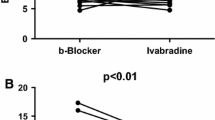Summary
Beta-adrenergic agonists can progressively lose their efficacy during chronic therapy in patients with heart failure. Ibopamine is a new dopamine derivative, active on dopaminergic and beta-adrenergic receptors, whose hemodynamic activity has been acutely demonstrated. To assess whether any attenuation of its efficacy occurs, the variations of the cardiac output induced during chronic therapy were monitored by impedance cardiography in 15 patients with dilated cardiomyopathy who showed a significant increase of the cardiac output (20.7 ± 10.0%) after acute ibopamine administration. The efficacy of ibopamine was also assessed after 6 and 12 months of therapy by echocardiography, exercise testing, and 24-hour dynamic electrocardiogram (EKG) monitoring.
The cardiac output response to ibopamine did not show any significant attenuation (range 15% to 19%) in the evaluations at 1, 2, 3, 4, 8, and 12 months of therapy. No significant change, was noted, after 6 and 12 months, in the exercise capacity (505 vs. 602 and 604 seconds) and the fractional shortening (16.2 vs. 18.3 and 18.5) without any change of the diastolic diameter. Ventricular arrhythmias were significantly reduced after 6, but not 12, months of therapy. No significant change in the New York Heart Association (NYHA) functional class was noted at 6 and 12 months of therapy (2.4 ± 5 vs. 2.3 ± 7 and 2.4 ± 0.6, respectively). Our results show that ibopamine can maintain its hemodynamic activity even during chronic therapy.
Similar content being viewed by others
References
Colucci WS, Alexander RW, Williams GH, et al. Decreased lymphocyte beta-adrenergic receptor density in patients with heart failure and tolerance to the beta-adrenergic agonist pirbuterol. N Engl J Med 1981, 305:185–190.
Bristow MR, Ginsberg R, Minobe W, et al. Decreased catecholamine sensitivity and beta-adrenergic receptor density in failing human hearts. N Engl J Med 1982; 307:205–211.
Lambertz H, Meyer J, Erbel R. Long-term hemodynamic effects of prenalterol in patients with severe congestive heart failure. Circulation 1984; 69:298–305.
Roubin GS, Choong CYP, Devenish-Meares S, et al. Beta-adrenergic stimulation of the failing ventricle: A double-blind, randomized trial of sustained oral therapy with prenalterol. Circulation 1984, 69:955–962.
Fowler MB, Laser JA, Hopkins GL, et al. Assessment of the beta-adrenergic receptor pathway in the intact failing human heart: progressive receptor down regulation and subsensitivity to agonist response. Circulation 1986; 74:1290–1302.
Lababidi Z, Ehmke DA, Durnin RE, et al. The first derivative thoracic impedance cardiogram. Circulation 1970; 41:651–658.
Delfino M, Carlone S, Angelici E, et al. Determinazione della gettata cardiaca mediante impedenza elettrica toracica: comparazione con la termodiluizione. G Ital Cardiol 1984; 14:101–107.
Celsi A, Imperatori A, Soffiantino F, Bernardi C. Riproducibilità delle misure di impedenza elettrica toracica. G Ital Cardiol 1986; 16:573–577.
Brusoni B, Sanna GP, Mangiavacchi M, et al. Control of a new classification of ectopic ventricular beats: “Italian Lown Classification”. In: Furlanello F, Disertori M, eds. “New Frontiers” of Arrhythmias. Florence: O.I.C. Medical Press, 1984;465–472.
Melloni GF, Minoja GM, Scarazzati G, et al. Renal Effects of SB 7505: A double-blind study. Eur J Clin Pharmacol 1981; 19:177–80.
Stefoni S, Coli L, Mosconi G, Prondini R. Ibopamine (SB 7505) in normal subjects and in chronic renal failure: A preliminary report. Br J Clin Pharmacol 1981; 1:69–72.
Melloni GF, Minoja M. Melloni R, et al. Effectiveness of ibopamine in the management of ascitic liver cirrhosis: a controlled study versus placebo and furosemide. BR J Clin Pharmacol 1981; 12:813–818.
Merlo L, Brusoni B, Mussoni E, Ghirardi P. Attività della Ibopamine su alterazioni della emodinamica del distretto renale indotte sperimentalmente nel cane narcotizzato. XLII Congresso Italiano Cardiologia Rome, 23–26, 1981.
Dei Cas L, Manca C, Bernardini B, et al. Non invasive evaluation of the effects of oral Ibopamine (SB 7505) on cardiac and renal function in patients with congestive heart failure. J Cardiovasc Pharmacol 1982; 4:436–440.
Opie LH. Inodilators. Lancet 1986; 1:1336.
Dei Cas L, Bolognesi R, Cucchini F, et al. Hemodynamic effects of ibopamine in patients with idiopathic congestive cardiomyopathy. J Cardiovasc Pharmacol 1983; 5:249–253.
Ren JH, Leithe ME, Huss P, et al. The effects of ibopamine on cardiovascular and renal function in normal human subjects. Curr Ther Res 1983; 34:667–675.
Luppi G, Cappello G, Pedrazzini F, Mattioli G. Effetti emodinamici dell'Ibopamina nell'insufficienza cardiaca cronica. G Clin Fisiopat Cardiovasc 1983; 2:51–64.
Ren JH, Unverferth DV, Leier CV. The dopamine congener, ibopamine, in congestive heart failure. J Cardiovasc Pharmacol 1984; 6:748–755.
Dei Cas L, Fappani A, Riva S, et al. Hemodynamic advantage of combined administration of oral ibopamine and nitroprusside in patients with ischemic and idiopathic congestive cardiomyopathy. Clin Cardiol 1985; 8:427–432.
Leier CV, Ren JH, Huss P, Unverferth DV. The hemodynamic effects of ibopamine, a dopamine congener, in patients with congestive heart failure. Pharmacotherapy 1986; 6:35–40.
Dei Cas L, Barilli AC, Metra M, et al. Multicenter study on the clinical efficacy of chronic ibopamine administration. Arzneimittelforsch 1986; 36:383–385.
Rajfer SI, Rossen JD, Douglas FL, et al. Effects of long-term therapy with oral ibopamine on resting hemodynamics and exercise capacity in patients with heart failure: Relationship to the generation of N-methyldopamine and to plasma norepinephrine levels. Circulation 1986; 73:740–748.
Franciosa JA, Wilen M, Ziesche S, Cohn JN. Survival in men with severe chronic left ventricular failure due to either coronary heart disease of idiopathic dilated cardiomyopathy. Am J Cardiol 1983; 51:833–836.
Gavazzi A, Lanzarini L, Cornalba C, et al. Dilated (congestive) cardiomyopathy follow-up study of 137 patients. G Ital Cardiol 1984; 14:492–498.
Schwarz F, Mall G, Zebe H, et al. Determinants of survival in patients with congestive cardiomyopathy: Quantitative morphologic findings and left ventricular hemodynamics. Circulation 1984; 70:923–928.
Goldberg LI, Rajfer SI. The role of adrenergic and dopamine receptors. In: Hospital Practice. New York: HP Publishing Co., 1985;67–80.
Goldberg LI, Rajfer SI. Dopamine receptors: Applications in Clinical Cardiology. Circulation 1985; 72:245–248.
Author information
Authors and Affiliations
Rights and permissions
About this article
Cite this article
Dei Cas, L., Metra, M., Nodari, S. et al. Lack of tolerance development during chronic ibopamine administration to patients with congestive heart failure. Cardiovasc Drug Ther 2, 221–229 (1988). https://doi.org/10.1007/BF00051238
Issue Date:
DOI: https://doi.org/10.1007/BF00051238




